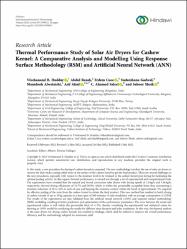| dc.contributor.author | Huddar, Vivekanand B. | |
| dc.contributor.author | Razak, Abdul | |
| dc.contributor.author | Cüce, Erdem | |
| dc.contributor.author | Gadwal, Sudarshana | |
| dc.contributor.author | Alwetaishi, Mamdooh | |
| dc.contributor.author | Afzal, Asif | |
| dc.contributor.author | Saleel, C. Ahamed | |
| dc.contributor.author | Shaik, Saboor | |
| dc.date.accessioned | 2023-01-10T13:14:54Z | |
| dc.date.available | 2023-01-10T13:14:54Z | |
| dc.date.issued | 2022 | en_US |
| dc.identifier.citation | Huddar, V., Razak, A., Cuce, E., Gadwal, S., Alwetaishi, M., Afzal, A. Saleel, C.A. & Shaik, S. (2022). Thermal Performance Study of Solar Air Dryers for Cashew Kernel: A Comparative Analysis and Modelling Using Response Surface Methodology (RSM) and Artificial Neural Network (ANN). International Journal of Photoenergy, 2022, 4598921. https://doi.org/10.1155/2022/4598921 | en_US |
| dc.identifier.issn | 1110-662X | |
| dc.identifier.uri | https://doi.org/10.1155/2022/4598921 | |
| dc.identifier.uri | https://hdl.handle.net/11436/7391 | |
| dc.description.abstract | In this study, a new procedure for drying of cashew kernels is proposed. The new methodology involves the use of solar air dryers to remove the dark sticky coating called testa on the surface of the cashew kernel to get the final product. There are several challenges in the new procedures, especially with respect to the moisture level to be retained in the cashew kernel post drying for facilitating the optimal peeling activity. In this regard, thermal performance is carried out through a set of experimental and computational trials. The experiments have revealed that the natural and forced convection solar dryers with drying speeds of 1.0 kg/h and 1.66 kg/h, respectively, showed drying efficiencies of 51.7% and 50.9%, which is within the permissible acceptable limit, thus ascertaining a moisture reduction of 40 to 42% in each of case and keeping the moisture content within the band of approximately 5%, required for effective peeling of the testa from the cashew kernel to obtain the final product. This new method has resulted in batch drying of cashew kernels of up to 30 kg capacity in a time span of 360 minutes of solar irradiation with an average consumption of 255 kJ. The results of the experiments are also validated from the artificial neural network (ANN) and response surface methodology (RSM) modelling, resulting in better prediction and optimization of the performance parameters. The error between the actual and experimental values is well within the permissible limit of +/-5%, thereby correlating the experimental and statistical values for deriving an ANN model for predicting the results for different time duration and solar irradiation. In this way, the thermal analysis of the solar dryers for drying cashew kernels has resulted in findings, which shall be utilized to improve the overall performance efficiency and the methodology adopted for maximum yield. | en_US |
| dc.language.iso | eng | en_US |
| dc.publisher | Hindawi | en_US |
| dc.rights | info:eu-repo/semantics/openAccess | en_US |
| dc.title | Thermal performance study of solar air dryers for cashew kernel: A comparative analysis and modelling using response surface methodology (RSM) and artificial neural network (ANN) | en_US |
| dc.type | article | en_US |
| dc.contributor.department | RTEÜ, Mühendislik ve Mimarlık Fakültesi, Makine Mühendisliği Bölümü | en_US |
| dc.contributor.institutionauthor | Cüce, Erdem | |
| dc.identifier.doi | 10.1155/2022/4598921 | en_US |
| dc.identifier.volume | 2022 | en_US |
| dc.identifier.startpage | 4598921 | en_US |
| dc.relation.journal | International Journal of Photoenergy | en_US |
| dc.relation.publicationcategory | Makale - Uluslararası Hakemli Dergi - Kurum Öğretim Elemanı | en_US |


















